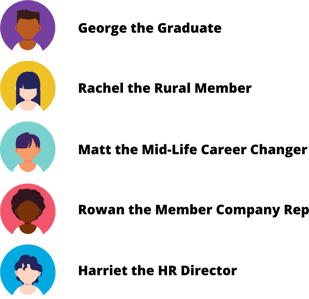Want to strengthen your member engagement strategy? Start with a better understanding of who you’re trying to engage. Member personas give you that clarity.
What is a member persona?
Member personas are representations of members with specific characteristics, such as attitudes/beliefs, backgrounds, wants/desires, opinions, skills, behavior patterns, goals, or personalities. They help you visualize your members in a more human and relatable way, beyond just job titles or demographics.
Member personas are sometimes called user personas.

Benefits of using member personas
Creating member personas helps you see how members are currently interacting with your organization. It also gives you a blueprint for more meaningful engagement. They can also inform how you build your member journey and refine touchpoints along the way.
While each member is unique, personas help you identify shared needs and motivations: what drives them to engage or tune out. When you understand this, you can tailor your approach to connect with them early, often, and with purpose.

5 tips for using member personas at your association, union, or nonprofit
💡 Tip: Go beyond segmentation data
Personas can help you understand the different motivations behind your member segments or target audiences. This in turn, can personalize their experience with your organization.
Here are some examples:
💡 Tip: Use relevant data you already have
Don't forget that you may already have data in your membership management system. As well as any anecdotes you and your staff may have come across. Centralize the data and make sure it is easily accessible. Hopefully you've established a Single Source of Truth, which will make it easier to wrangle your member data.
Understand the motivation of your members and prospects
What motivates your members or prospective members to engage with your organization? Some may be drawn to your events, while others are more interested in resources or certifications. You may even have users who haven’t joined yet but still find value in your offerings.
Understanding what matters most to them, what truly drives their interest, helps you tailor your outreach and better align your value proposition.
Consider their current career status
Your members’ goals and needs often shift based on where they are in their career. Mapping out key career stages can help you group members by similar motivations or challenges.
A student or early-career professional may need guidance and networking. But a mid-career member might instead prioritize leadership opportunities. Their current role or experience level can also influence how engaged they are, and how engaged they want to be, with your organization.

Look for friction points
What’s getting in the way of your members' success? Common barriers like confusing onboarding, hard-to-find resources, or lack of clarity on benefits, can reduce engagement. By identifying these friction points, you can create smoother, more supportive experiences that make members feel seen.
Pay attention to repeat feedback, frequently asked questions, or common complaints. Even if the issue doesn’t stem directly from your organization, understanding what your members struggle with in your space can help you proactively address their needs. Spot the patterns and then take steps to remove the roadblocks.

Variables for drop-off (especially within the first year)
Knowing why members lapse can greatly help in retaining your members. If you can spot trends, you can come up with a solid plan to combat the negative trend.
For this type of data, consider consulting with your staff for information they may already have. Supplement this by gathering data through surveys and direct conversations with your members.

This can be a single factor or combination of factors such as:
💡 Tip: Remember the "Person" in "Personalize"
Try to add as many personal elements as possible. This helps visualize and collect the various tidbits of information. Using stock photos and other details help personify the collection of data you are using for your personas.
A great tip is to use intuitive identifiers for your member personas. They can be simple, but making them memorable will make it easier for them to stay top of mind.
Member persona name examples:

Consider creating a visual map of each persona's journey. This powerful representation helps you identify gaps and opportunities for your union, nonprofit, or association members.

💡 Tip: Normalize using personas across your organization
Personas may have started as a marketing tool, but can and should be used by multiple departments. Consider how different departments or organization activities can benefit from a consistent use of personas. Gather all departments to discuss how each can make use of your personas:
- Marketing: Personas help tailor your communications and interactions. By understanding your users, your marketing can be geared towards more specific interests.
- Product Development: Personas provide insight into needs and pain points. This can guide your organization's offerings to address real user needs.
- Customer Service: Personas help your front-line staff to offer more personalized support. They can anticipate common issues and address them in a meaningful way depending on your grouping. The better the custom service, the better retention you'll have for your nonprofit, union, or association members.
- Sales: Personas help to better understand the motivations and decision-making processes of your members and prospective members. This can aid in developing compelling messaging that would appeal to your targets.
- Content Creation: Content creators can tailor content to speak directly to the interests and challenges of your users. This makes your content more engaging and relevant to encourage user interaction.
By integrating personas into your strategies and processes, organizations can create a holistic and engaging experience.
💡 Tip: Build in a scheduled review for continuous performance improvement
One pitfall to avoid is letting your member personas become outdated or inaccurate.
Building in a feedback loop will ensure that your member personas stay fresh and relevant. Consider reviewing them on a regular basis and adjust as you get more information and insight. This works best when the personas are centralized and accessible by the whole team.